Blade Number Effects in Radial Disc Pump Impellers: Overall Performances with Cavitation Sensitivity Analysis
Abstract
:1. Introduction
2. Disc Pump Models and Meshes
2.1. Disc Pump Models
- On the left side of Figure 2, the physical model of impeller A can be seen from the shaft side. The blade number ZA is equal to 8, each blade height value is hA = 0.004 m, and the disc spacing value is: bA = 0.016 m. Eight balance holes are placed near the drive shaft on the hub disc. Detailed impeller geometry information can be found in the reference [20].
- The right side of Figure 2 shows the physical model of impeller B seen from the flow entrance section. The blade number ZB is equal to 10 with a blade height of hB = 0.00715 m. The disc spacing value is bB = 0.022 m. Ten balance holes are located near the drive shaft as well.
2.2. Grid Independence Verification for CFD Approach
3. Mathematical Model
3.1. Turbulence Model
3.2. Cavitation Model
3.3. Boundary Condition
4. Experimental Results and Numerical Simulation
4.1. Test Stand
4.2. Overall Performance Results
- First, between flow coefficient values of 0 up to 0.06, all curves give the same head evolution whatever the rotational speeds for each model. This obeys the non-dimensional analysis result for which head-versus-flow coefficients are independent of the rotational speed for a given pump as for conventional designs.
- Second, the rotational speed has an effect of the performance chart for a flow coefficient higher than 0.06 for both models. The greater the rotational speed is, the greater is the decrease. However, the head rate decrease in the pump performance is more pronounced for model B than for model A. This effect is attributed to a different experimental cavitation onset inside both models’ impeller passages and is discussed and evaluated in the next section. The more pronounced relative head decrease of model B performances allows us to expect that model A should be less sensitive to cavitation effects than model B.
4.3. Comparison between Experiments and CFD Results
5. Discussion on Pump Performances and Cavitation Effects, Local Performance Analysis
5.1. Performance Analysis without Cavitation, n = 2900 rpm, φ = 0.1
- Along the radial direction between R = 0.06 m and 0.1 m, the rotation effects create an increase in the pressure coefficient. It should be noted that the pressure coefficient is mainly independent of the rotational speed for n = 2000 rpm and below. This is coherent with the results of classical similarity laws applied in rotating machineries when assuming incompressible and steady flow conditions for a sufficiently high Reynolds number. This pressure increase is clearly lower than the ideal one due to the losses inside the impeller passage.
- The Cp value remains at zero up to R = 0.08, which means that pressure losses destroy the potential pressure increase that should have been obtained by the impeller rotation. This effect is mainly related to the incidence losses occurring on the radial shroud blade’s leading edge.
- The ideal pressure coefficient can be expressed according to the momentum equation applied in the relative frame inside the impeller, assuming a one-dimensional approach, steady flow conditions and incompressible media. It can be written as follows:
5.2. Performance Analysis with Cavitation Effects, n = 2900 rpm, φ = 0.1
- It can be observed that the impeller performance drastically decreases when the absolute inlet pressure is below 0.2 MPa. This indicates that disc pumps are much more sensitive to cavitation than conventional pumps and must be used in at least 10 m of water under sea level conditions.
- The static pressure increase inside the impeller becomes negligible when the inlet absolute pressure is set to 0.07 MPa, which corresponds to the experimental measured value. The effect of the cavitation onset starts at the radial location R = 0.06 m, which corresponds to the blade leading edge placed on the shroud disc, as shown in Figure 13.
- This is a confirmation of the performance decrease measured during the experimental campaign for several rotational speeds that are discussed in Section 4.2, in relation to comments in Figure 5. As an example, a rapid evaluation of the relative velocity that impinges the blade’s leading edge for n = 2900 rpm, φ = 0.1 at R = 0.06 gives W0.06 = 19 m/s. The corresponding dynamic pressure is equal to 0.1785 MPa. This means that the pressure vapor limit is reached when the inlet pressure is below 0.2 MPa. This corresponds well with the results obtained through the CFD approach. This is the reason why no cavitation was detected for n = 1500 rpm and below during the experimental campaign.
5.3. Cavitation Sensitivity of Both Impellers
6. Conclusions
- Experimental and CFD results are in good agreement for both impeller model cases for a wide range of flow rates.
- Increasing the blade number from 8 to 10 with a 30% increase in the blade height ratio strongly modifies the pump performance characteristics. Head curve variation versus flow coefficient exhibits a flatter curve in the case of 10 blades compared with 8 blades of constant thickness.
- The head pump increases for a higher disc spacing. This is the direct consequence of the modification to the velocity triangle at the impeller outlet. For the same flow rate, the mean radial velocity component decreases resulting in an increase in the absolute tangential velocity component and, consequently, in the work given to the fluid. However, the relative influence of the distance between the two rotating discs for a given blade number and a given blade height ratio needs to be investigated in the future.
- An increase in the blade height associated with a larger disc gap also contributes to an increase in the pump’s efficiency. This is related to a reduced gap leakage between impeller model A and B. For model A, this relative gap is equal to 0.5, whereas it is reduced to 0.35, corresponding to a potential relative diminution of 30% on tip leakage loss in the bladeless part of the impeller.
- Disc pump models A and B are both very sensitive to a cavitation occurrence because of the radial blade configuration. Inlet pressure requirement avoiding cavitation requires an inlet absolute pressure of 0.2 MPa for the maximum rotational speed of 2900 rpm and 0.15 MPa for a 3% head decrease allowance for conventional pump designs. These pressure conditions are currently observed in marine sub-sea applications.
- Cavitation was not detected for rotational speeds below 1500 rpm for atmospheric inlet pressure conditions over the whole range of flow rates examined in the present test results.
- The present results can be used as a database to establish semi-empirical design laws for disc pumps equivalent to the one already developed for conventional pumps for single conditions. However, experimental campaigns with variable inlet two-phase air liquid mixtures are still necessary to provide a complete analysis concerning the future objective of the present research.
Author Contributions
Funding
Institutional Review Board Statement
Informed Consent Statement
Data Availability Statement
Conflicts of Interest
Abbreviations
| b | impeller passage width (m). Disc spacing (m) |
| Cp | pressure coefficient |
| D | diameter (m) |
| g | acceleration (m2/s) |
| h | blade height(m) |
| H | head (m) |
| Ps | shaft power (W). |
| Pt | total pressure (Pa) |
| p | static pressure (Pa) |
| Q | volume flow rate(m3/h) |
| R | radius (m) |
| U | impeller speed (m/s) |
| n | rotational speed (rev/min) |
| Z | number of blades |
| flow coefficient | |
| Ψ | head coefficient |
| η | efficiency (%) |
| Υ | ratio |
| Subscripts | |
| A | impeller model A |
| B | impeller model B |
| 0 pump inlet section | |
| 1 | impeller inlet section |
| 2 | impeller outlet section |
| 3 | casing base circle |
| cav | related to cavitation |
| id ideal | |
| in | pipe inlet |
| out | pipe outlet |
References
- Tesla, N. Fluid Propulsion. U.S. Patent 1061142, 6 May 1913. [Google Scholar]
- Gurth, M. Rotary Disc Slurry Pump. U.S. Patent 4773819, 27 September 1988. [Google Scholar]
- Gurth, M. Rotary Disc Pump. U.S. Patent 4940385, 10 July 1990. [Google Scholar]
- Gurth, M. Rotary Disc Pump. U.S. Patent 7097416B2, 29 August 2006. [Google Scholar]
- Chen, Y.; Chen, G. Analysis on the influence of blade structure on exterior characteristics of disc pump. J. Mech. Des. 2014, 31, 93–96. [Google Scholar]
- Gao, B. Flow Field Simulation and Performance Assessment for the Subsea Mud Lift Disc Pump. Master’s Thesis, China University of Petroleum (East China), Qingdao, China, 2009. [Google Scholar]
- Zhang, Y. Study on Design Application Method for Subsea Mud Lift Disc Pump. Master’s Thesis, China University of Petroleum (East China), Qingdao, China, 2015. [Google Scholar]
- Yin, S.; Chen, G.; Zhou, C. New-type impeller design and performance prediction for disc pump. Fluid Mach. 2012, 40, 19–23. [Google Scholar]
- Pei, Y.; Liu, Q.; Wang, C.; Wang, G. Analytical methods, and verification of impeller outlet velocity slip of solid–liquid disc pump with multi-type blades. Arab. J. Sci. Eng. 2020, 46, 6835–6847. [Google Scholar] [CrossRef]
- Heng, Y.; Han, Y.; Zhang, H.; Zhang, W.; Bois, G.; Jiang, Q.; Wang, Z.; Lui, X. Tesla bladed pump (disc bladed pump) preliminary experimental performance analysis. Energies 2020, 13, 4873. [Google Scholar] [CrossRef]
- Heng, Y.; He, K.; Jiang, Q.; Zhang, W.; Bois, G.; Liu, X. An Analysis on Hydraulic Loss in a Co-Rotating Bladed Disc Pump. J. Mar. Sci. Eng. 2022, 10, 214. [Google Scholar] [CrossRef]
- Discflo-Disc Pump. Available online: https://discflo.com (accessed on 16 July 2021).
- Zhang, W.; Li, H.; Kun, S.; Jiang, Q.; Bois, G. Internal Cavitating Flow Distribution and Performance Comparison of a Disc Pump with Radial Straight Blade. J. Mar. Sci. Eng. 2022, 10, 1641. [Google Scholar] [CrossRef]
- Ye, Y.; Zhu, X.; Lai, F.; Li, G. Application of the semi-analytical cavitation model to flows in a centrifugal pump. Int. Commun. Heat Mass Transf. 2017, 86, 92–100. [Google Scholar] [CrossRef]
- Liu, W.; Jiang, H. Partially-Averaged Navier-Stokes Model for Predicting Cavitating Flow in Centrifugal Pump. Eng. Appl. Comput. Fluid Mech. 2014, 8, 476. [Google Scholar] [CrossRef]
- Zhou, C.J.; Cheng, G.M.; Tan, H.D. Numerical simulation of flow in solid-liquid Blade disc pump volute. Chem. Eng. Mach. 2014, 41, 501–504. [Google Scholar]
- Zhou, C.J.; Qu, Y.; Zhang, D.H.; Gao, B. Influence of Particle characteristics on the distribution of solid particles in the disk impeller with radial straight blade. Fluid Mach. 2015, 43, 14–18. [Google Scholar]
- Chen, Y.C.; Chen, G.M.; Yin, S.M.; Zhou, C.J.; Lv, T. Modal analysis on the impeller of disc pump with radial straight blade based on fluid-structure interation. J. Mech. Strength 2014, 36, 134–138. [Google Scholar]
- Wang, C.; Zhang, B.H.; Fei, Y.J.; Wang, D.B. Research on unsteady characteristics and inflow mechanism of different pumping chamber of disc pump. J. Eng. Therm. Energy Power 2021, 36, 17–22. [Google Scholar]
- Heng, Y.; Jiang, Q.; Han, Y.; Zhang, W.; Bois, G.; Wan, Z.; Lui, X. Tesla Bladed Disc Pump Hydraulic Performance. In Proceedings of the 14th European Conference on Turbomachinery Fluid Dynamics and Thermodynamics, ETC 14, Gdansk, Poland, 12–16 April 2012. Paper ID: ETC 21.448. [Google Scholar]
- Zwart, P.; Gerber, A.G.; Belamri, T. A two-phase model for predicting cavitation dynamics. In Proceedings of the ICMF2004 International Conference on Multiphase Flow, Yokohama, Japan, 30 May–3 June 2004. Paper No.152. [Google Scholar]
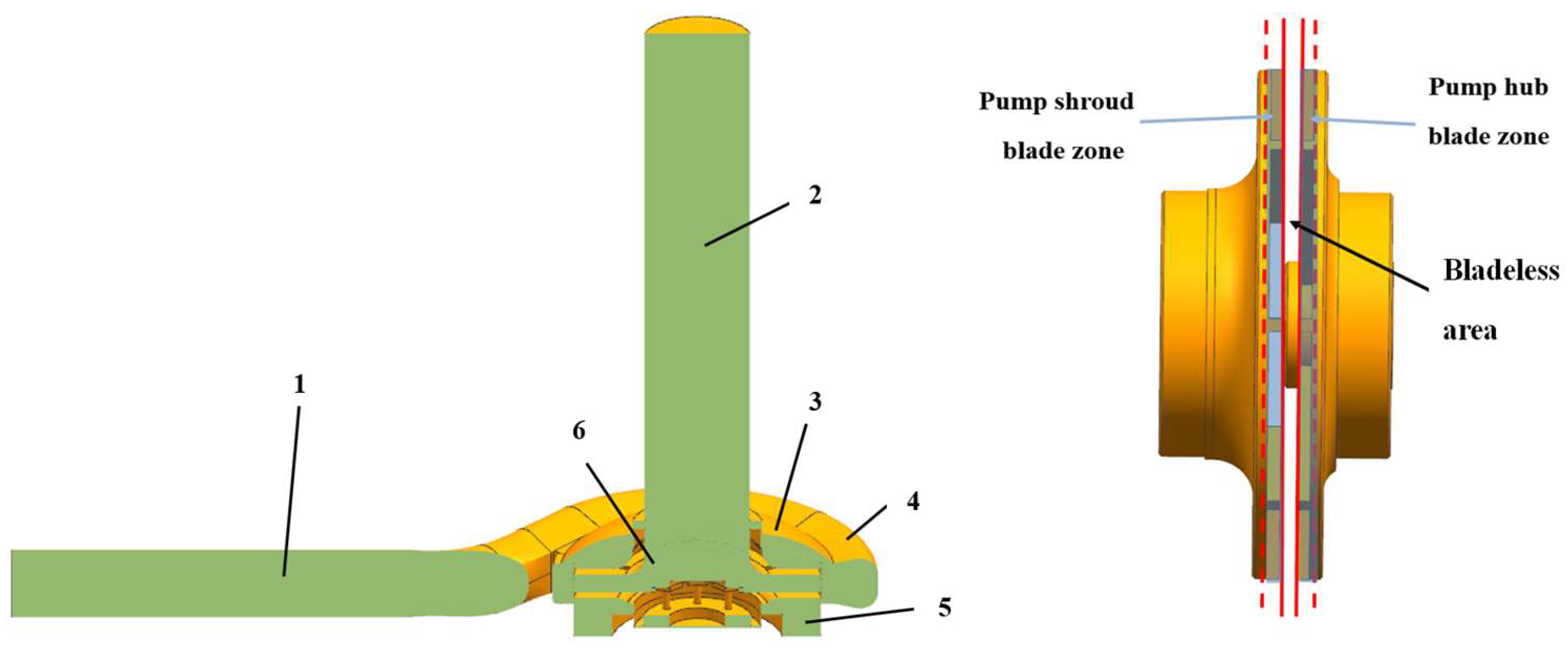
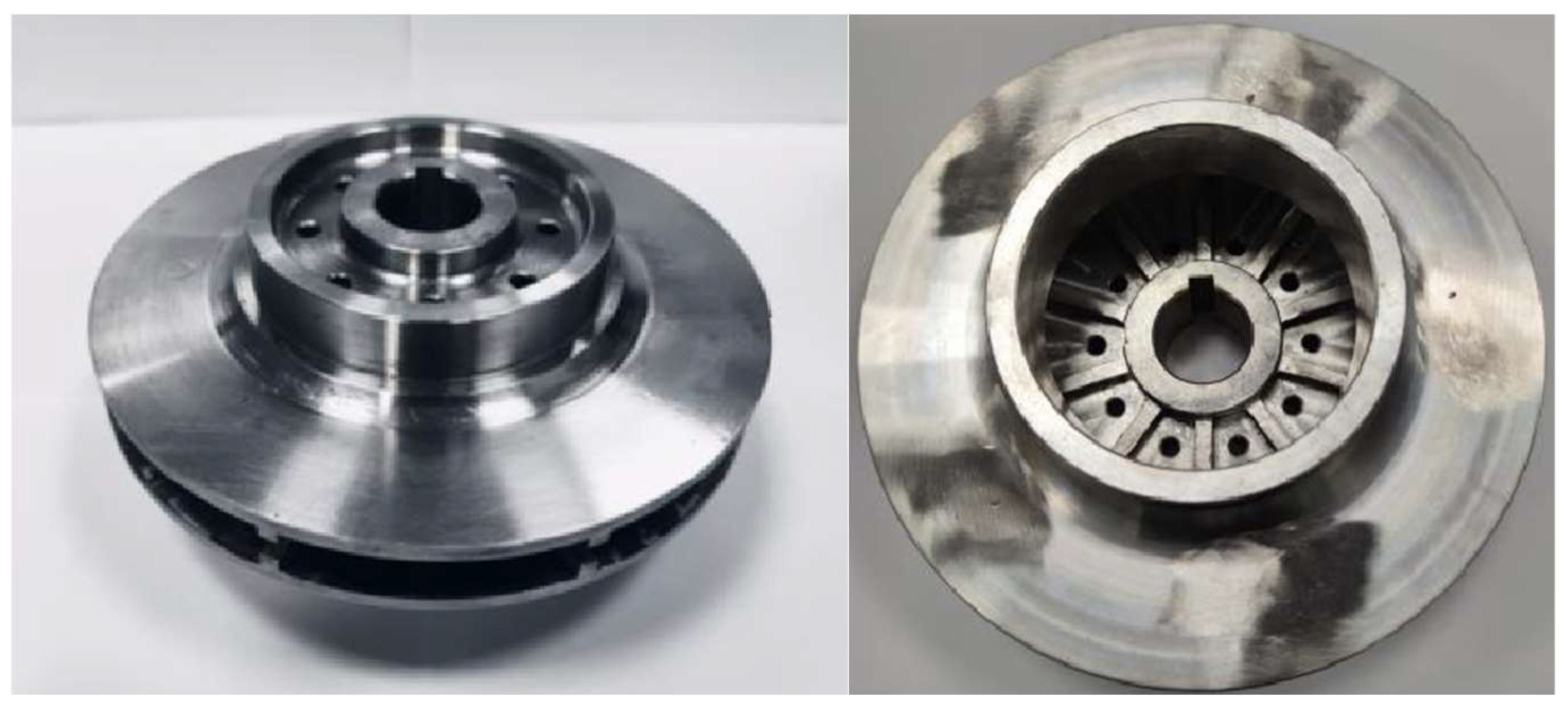


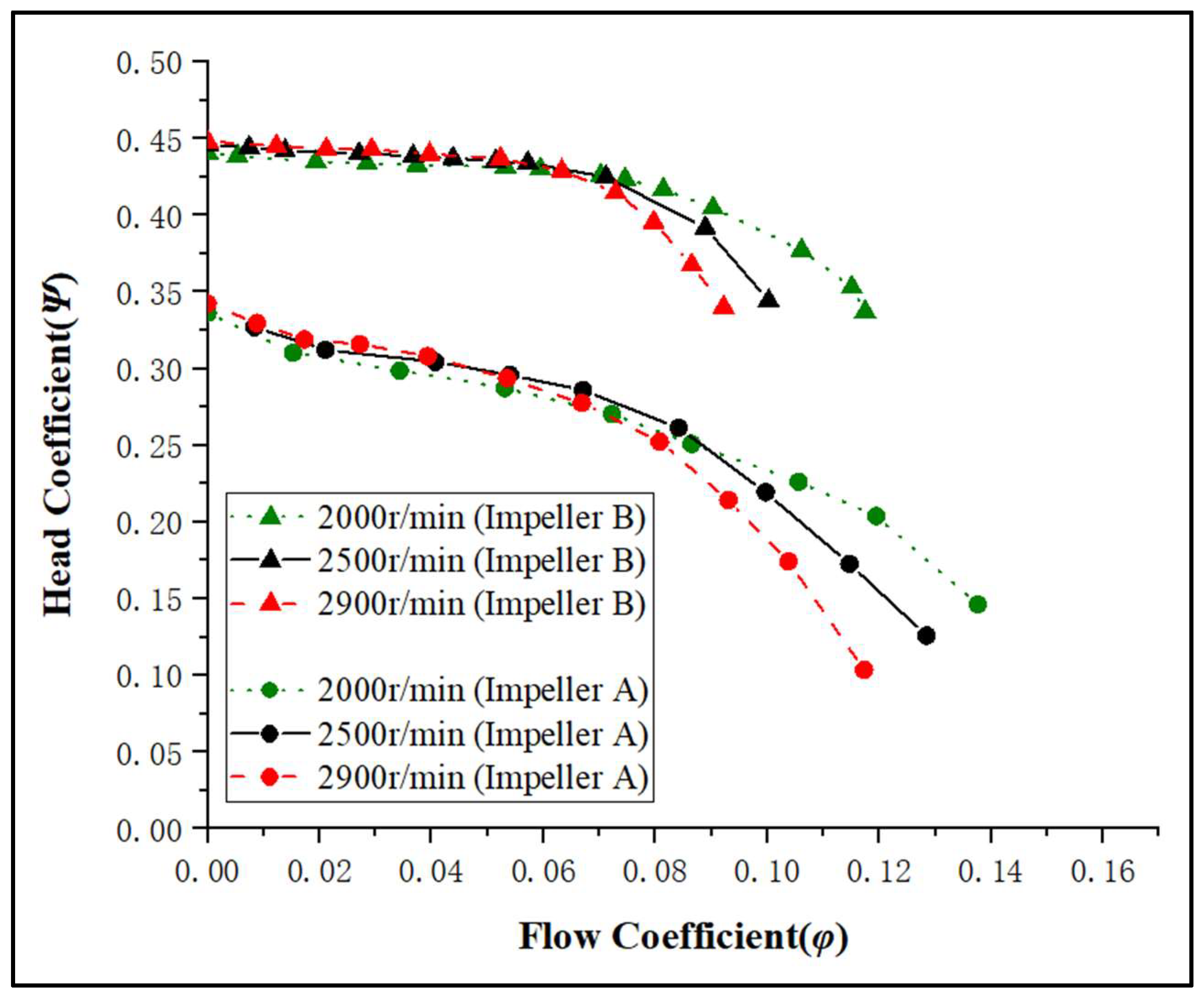

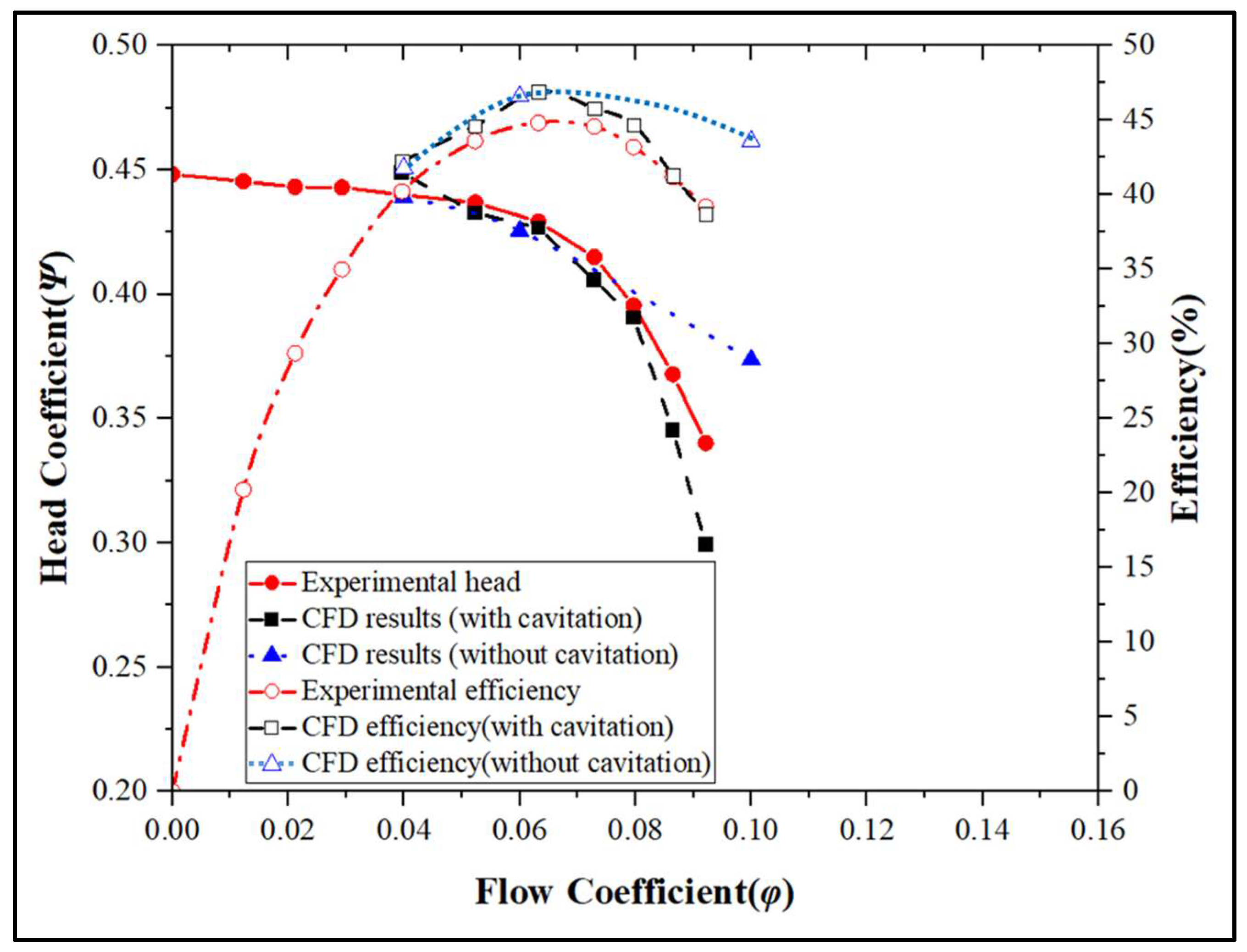

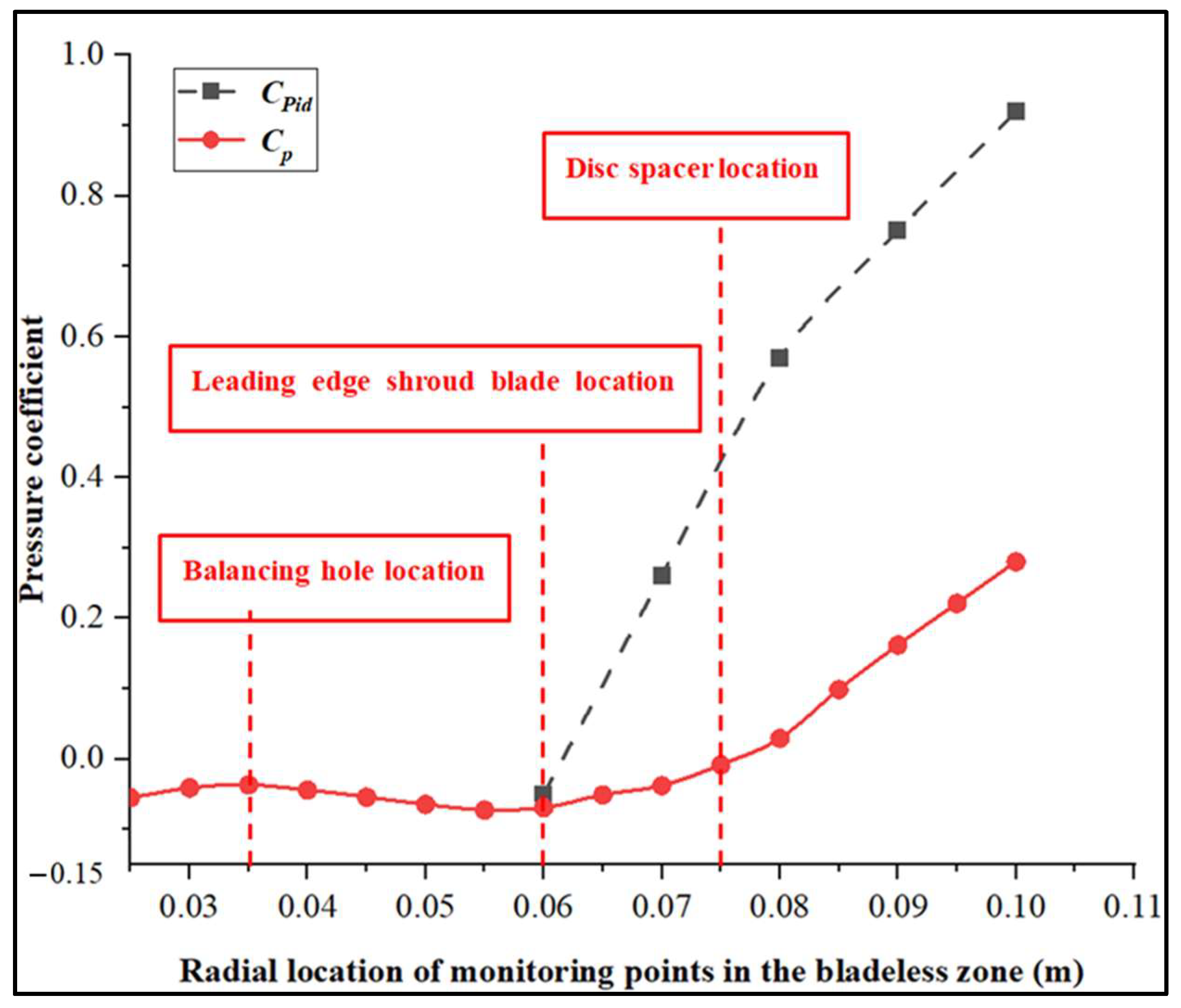

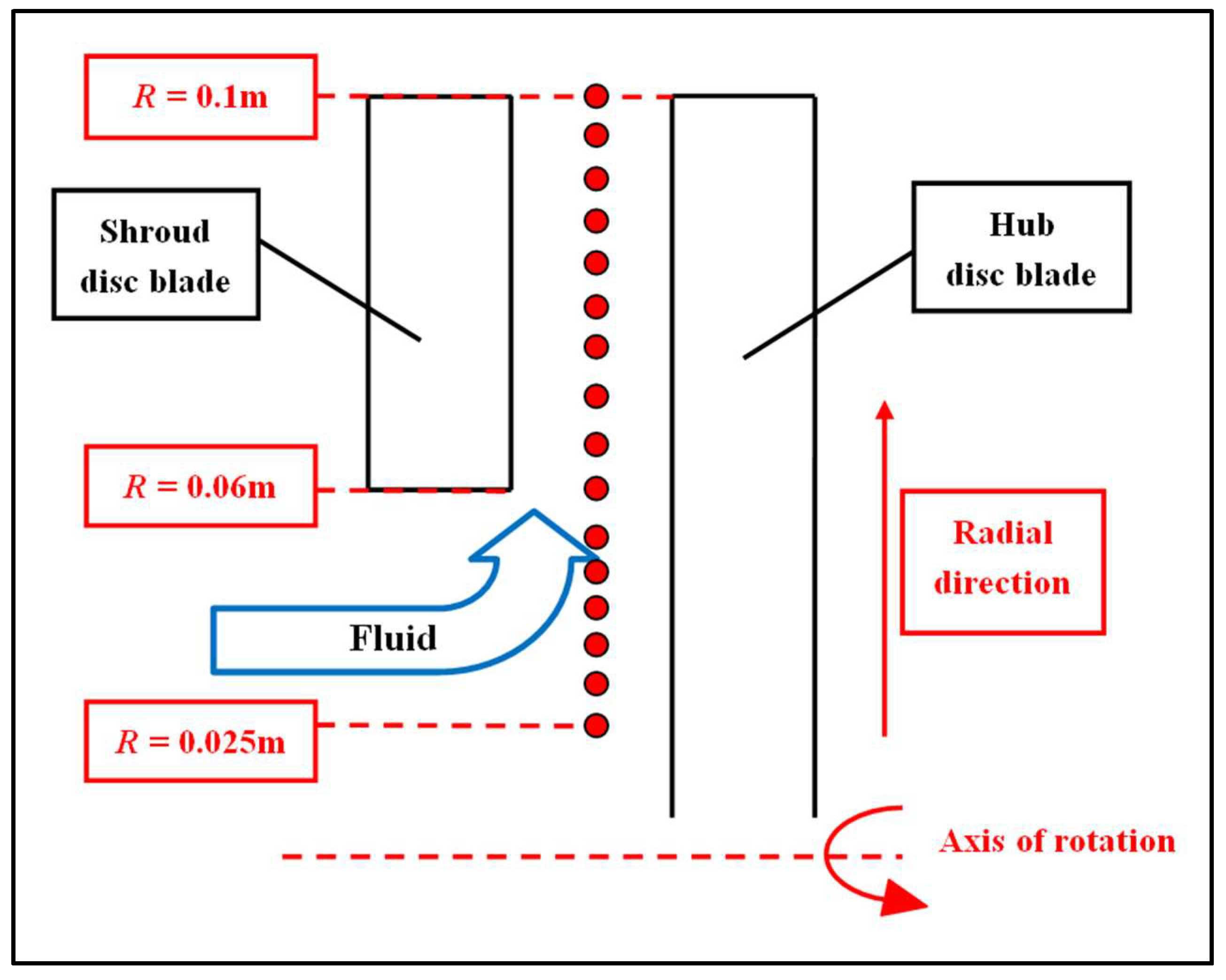
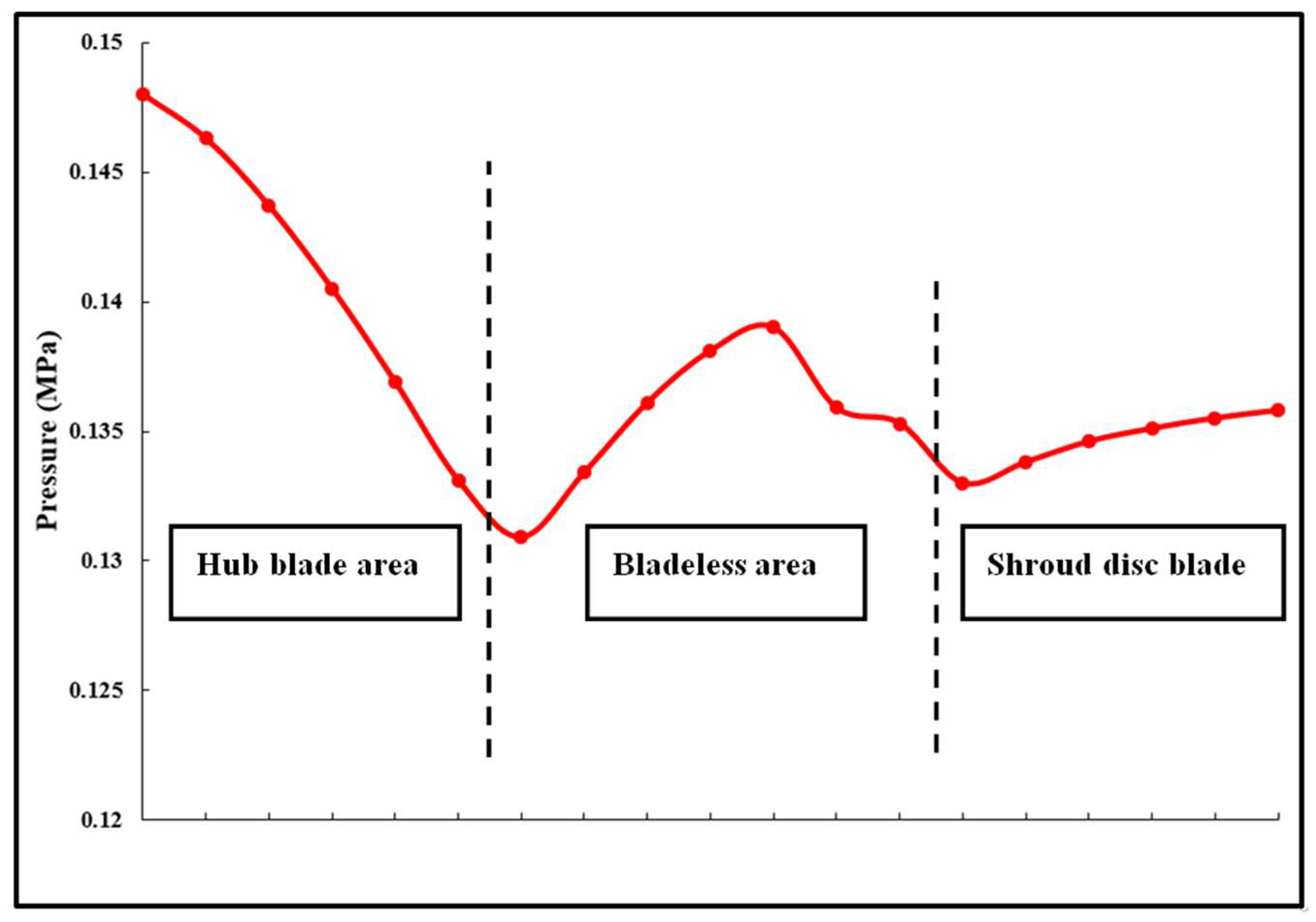
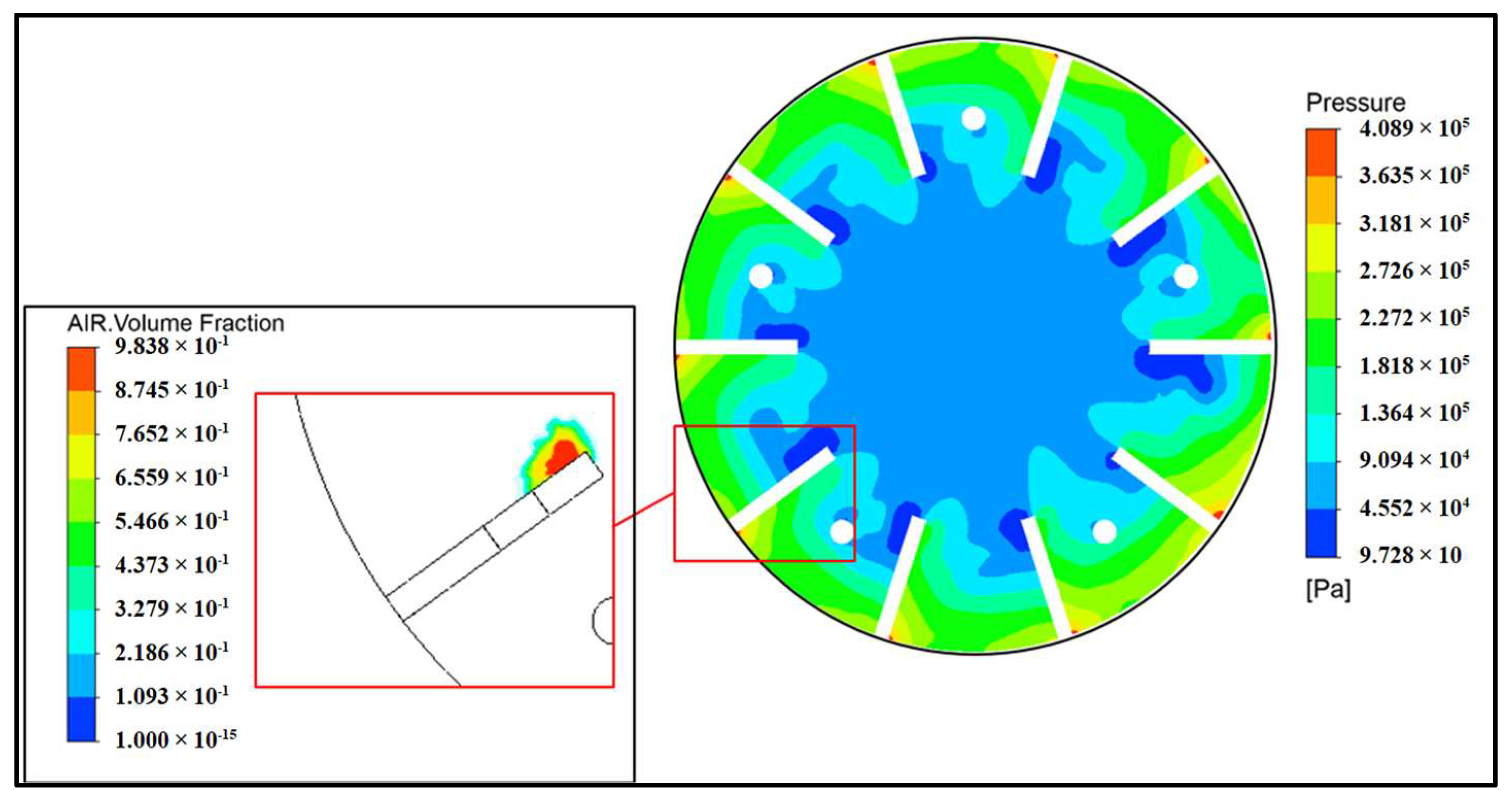
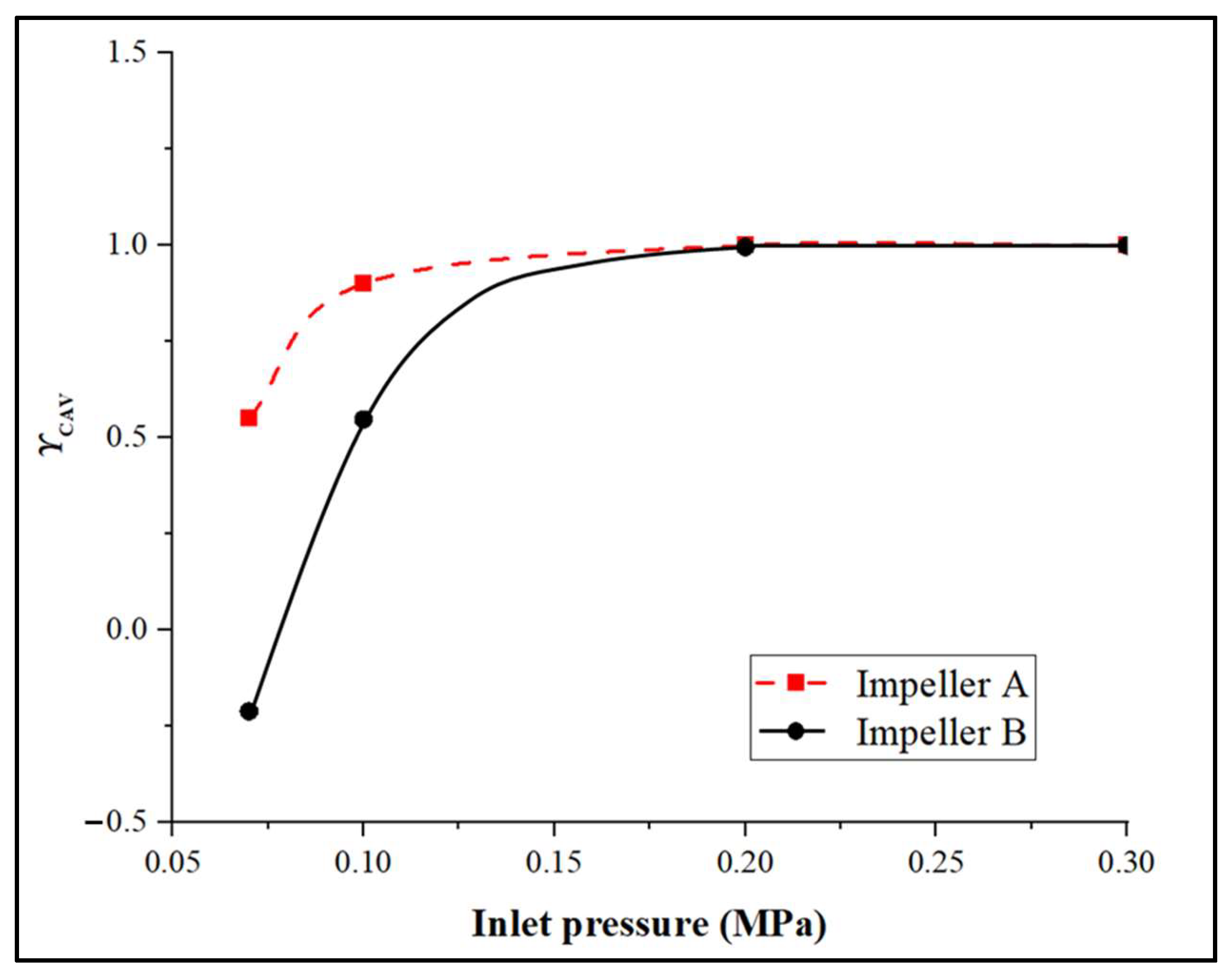
| Major Parameter | Symbols | Value | Units |
|---|---|---|---|
| max rotation speed | n | 2900 | r/min |
| number of blades | ZA/ZB | 8/10 | - |
| blade height | hA/hB | 0.004/0.00715 | m |
| impeller passage width | bA/bB | 0.016/0.022 | m |
| impeller inlet diameter | D1 | 0.088 | m |
| impeller outlet diameter | D2 | 0.200 | m |
| base circle diameter of casing | D3 | 0.220 | m |
| inlet pipe diameter | Din | 0.088 | m |
| outlet pipe diameter | Dout | 0.064 | m |
| Mesh Number (Million) | Computing Time (h) | Outlet Pressure (MPa) | Convergence Ratio |
|---|---|---|---|
| 8.39 | 4.7 | 0.3793 | |
| 9.12 | 4.9 | 0.3682 | 0.3010 |
| 13.77 | 6.5 | 0.3621 | 0.01682 |
| 15.31 | 7 | 0.3634 | 0.00357 |
Disclaimer/Publisher’s Note: The statements, opinions and data contained in all publications are solely those of the individual author(s) and contributor(s) and not of MDPI and/or the editor(s). MDPI and/or the editor(s) disclaim responsibility for any injury to people or property resulting from any ideas, methods, instructions or products referred to in the content. |
© 2023 by the authors. Licensee MDPI, Basel, Switzerland. This article is an open access article distributed under the terms and conditions of the Creative Commons Attribution (CC BY) license (https://creativecommons.org/licenses/by/4.0/).
Share and Cite
Jiang, Q.; Liu, C.; Bois, G.; Heng, Y. Blade Number Effects in Radial Disc Pump Impellers: Overall Performances with Cavitation Sensitivity Analysis. J. Mar. Sci. Eng. 2023, 11, 2104. https://doi.org/10.3390/jmse11112104
Jiang Q, Liu C, Bois G, Heng Y. Blade Number Effects in Radial Disc Pump Impellers: Overall Performances with Cavitation Sensitivity Analysis. Journal of Marine Science and Engineering. 2023; 11(11):2104. https://doi.org/10.3390/jmse11112104
Chicago/Turabian StyleJiang, Qifeng, Chen Liu, Gérard Bois, and Yaguang Heng. 2023. "Blade Number Effects in Radial Disc Pump Impellers: Overall Performances with Cavitation Sensitivity Analysis" Journal of Marine Science and Engineering 11, no. 11: 2104. https://doi.org/10.3390/jmse11112104
APA StyleJiang, Q., Liu, C., Bois, G., & Heng, Y. (2023). Blade Number Effects in Radial Disc Pump Impellers: Overall Performances with Cavitation Sensitivity Analysis. Journal of Marine Science and Engineering, 11(11), 2104. https://doi.org/10.3390/jmse11112104






